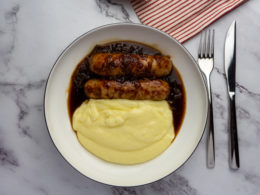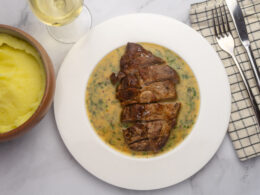French Confit Duck is a thing of beauty, soft, succulent duck meat under a wrapping of crispy skin. In French it’s called confit de canard and it’s found in the best bistros in Paris and across France and for good reason. The idea of using large quantities of fat to cook something slowly can be daunting to many but fear not, it’s actually really easy and the fat can be kept for months. If you want to try a French classic and learn a great technique then read on! But first..
What Does Confit Mean?
Confit is a French verb meaning to slowly cook something (meat, fish or vegetables) in fat. Usually the fat is the same fat of what you’re cooking. For example, confit duck for example is traditionally cooked in rendered duck fat whereas confit tomatoes are cooked in olive oil. Typically a confit dish will be cooked at between 100-120c/212-248f.
It historically was a method of preserving food before refrigerators existed. Meat was salted, cooked and then covered in fat. The combination of high levels of salt and solidified fat covering the food meant that bacteria couldn’t grow which prevented spoilage.
In French it’s confit if the object being cooked is of a masculine gender (duck, or canard for example) and if it’s female (tomatoes for example), it’s confite.
Classic French Confit Duck Leg & Crispy Duck Fat Potatoes
Our French confit duck leg recipe is very French as we serve it with duck fat fried potatoes seasoned with lots of garlic, parsley and finely minced shallot. In French this is called pommes sarladaise and it’s a delicious potato dish and is very common to find in France – especially served with duck.
The first step in this recipe is to cure the duck legs. Curing just means to salt the raw duck legs to remove moisture, tenderise the meat and to produce a better flavoured end product. You don’t need to be precise about this, just liberally salt the legs all over and add garlic and herbs of extra flavour. Cover and leave in the fridge overnight.

The next day the legs need to rinsed under cold water to remove the salt. Once dried the decks legs are placed in a small baking dish or tray. To ensure that you don’t have to use too much fat, pick a container that’ll just fit the duck legs in snuggly. Pour over melted duck fat over the duck legs and ensure that they’re completely submerged. Depending on the container you’ll need between 600-900g of duck fat. Duck fat keeps for months in the fridge and you can reuse it to confit more duck legs or use for roast potatoes.

The container should then be covered with foil and put into a low oven at 110c/230f for between 3-4 hours. Once a knife or a cake tester goes into the meat without resistance it’s ready! Leave the duck legs to cool in the fat and transfer to the fridge until cold. This helps to keep the legs even juicer and allows you to get a crispy skin without the meat falling off the bone (oh yes, it’s that tender!).

Crispy Duck Fat Potatoes (Pommes Sarladaise)
Potatoes pan fried in duck fat and then tossed with lots of garlic are a French classic. It’s awesome and it’s one of my favourite side dishes to eat out in Paris and make at home!
Potatoes are peeled and sliced to about 1cm or 1/3 inch thick, boiled for 1 minute and drained. They’re then added to a large pan with duck fat and fried until crispy and golden. A handful of persillade or finely chopped garlic, shallots and parsley are added at the last minute and tossed to cook and combine.

What You’ll Need
To make a classic French confit duck and duck fat potatoes you’ll need the following:
- Duck Legs: Uncooked duck legs from any variety of duck will work for this recipe (Pekin, Gressingham etc). Note that duck breast will not work for this recipe. You can of course buy a whole duck and remove the legs to confit.
- Duck Fat: Duck fat is the preferred fat to confit the legs in. You can use goose fat if duck fat is not available. If you can’t get your hands on either then you can use a neutral flavoured oil (avocado, canola).
- Cure: You only really need to use salt to cure the duck legs but I use garlic and any other herbs that I have around such as thyme or rosemary.
- Potatoes: For the potatoes you want to use a floury potato such as Russet or Maris Piper. You can use fingerling or baby potatoes and follow the same steps but you won’t get the same crispy edges.
- Persillade: A classic French seasoning, Persillade is in its simplest form just parsley and garlic. Here I add minced shallots to add even more flavour – you can omit if you don’t have shallots at hand.

Ingredients
Makes enough for 2 people.
For the confit duck:
- 2 raw duck legs
- 600g-900g of duck fat
- 1 garlic clove, 1 finely sliced
- 1/2 shallot, finely minced
- 1 handful of parsley, finely chopped
- Thyme, rosemary, bay leaf, as required
For the duck fat potatoes
- 500g of potatoes (Russet in the US, Maris Piper in the UK and Bintje in France)
- 3 tablespoons of reserved duck fat
- 2 garlic cloves, finely minced
- 1/2 shallot, finely minced
- 1 small handful of parsley, finely chopped
How to Make Confit Duck & French Style Potatoes
- Cure the duck legs. Liberally salt the duck legs with kosher or fine salt and ensure all sides are covered in a fine layer. Add thin sliced garlic and chopped herbs over the meat side. Reserve in the fridge overnight or at least for 1 hour.
- Rinse the duck legs with cold water and pat dry. Add the duck legs to a small baking dish or oven safe container.
- Melt the duck fat and pour over the duck ensuring that the legs are fully submerged.
- Place into a 110c/230f oven for 3 to 4 hours. Remove and either use a knife or a cake tester and place through the duck legs. If it goes through the duck leg with ease then it’s ready. Once ready, remove from the oven and let the duck legs sit in the fat until cool. Place into the fridge until the cold.
- Once ready to cook, remove the duck legs from the fat and place into a 140c/240f oven to warm the duck through – about 15 minutes. Remove and place skin-side down in a frying pan on a medium heat and press with a heavy pot or pan. Fry until the skin is crispy – about 5 minutes.
- For the potatoes, peel and slice into 1cm or 1/3 inch rounds and rinse in cold water to remove excess starch (starch stops them from going crispy!). Boil in salted water for 1 minute and drain.
- Add the potatoes to a large pan on a medium heat along with the duck fat. Fry, flipping regularly for 10 minutes.
- When they’re ready add your persillade (garlic, parsley and shallot mixture) to the potatoes and toss or stir vigorously coat the potatoes and to cook the garlic.
- Serve the potatoes with the crispy confit duck with a green salad.
What to Serve with Confit Duck
Confit duck is very versatile and can be served with different side dishes. In the South West of France it’s famous for being served on top of cassoulet – a famous bean and pork stew. In this recipe we’ve served the duck with duck fat potatoes (pommes sarladaise) and a green salad. Our salad has been dressed with a classic vinaigrette – find our French vinaigrette recipe below:
Classic French Vinaigrette Recipe
Confit Duck with Lentils
Confit duck leg goes really well with lentils and is another classic French combination. Green lentils or Puy lentils are simmered with carrots, onion, garlic and bacon lardon resulting in a delicious meal. We’ve cooked it with sausages but replacing them with duck works a treat! Find our lentil stew recipe below:
French Lentil Stew Recipe
Confit Duck with Bean Stew
Another great option is to go full South-West France and serve it with a Cassoulet style bean stew. Our recipe is super easy and can be made with canned beans – it’s healthy and super delicious. Check it out below:
Cassoulet Style Bean Stew
Confit Without Duck Fat
Can you confit duck without duck fat? Yes! Confiting just means to cook something slowly in fat but it doesn’t have to be duck fat. If you can’t find duck fat then you can use a neutral flavoured oil such as avocado or canola. You won’t have quite the same end flavour but the duck will still be extremely tender and delicious!
Are Confit Duck Legs Already Cooked?
Yes, confit duck legs are already cooked. You will typically find them vacuumed sealed in stores surrounded by a bit of duck fat. You can also find them canned although they’re not as good as fresh, confit duck.
In France they’re easy to find in supermarkets and butcher shops and a leg will typically cost between €4-5.















